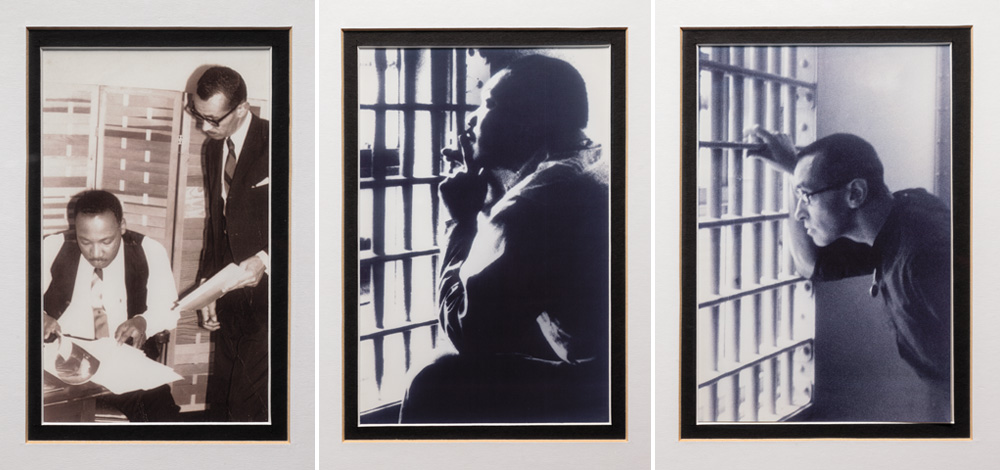
Left: Photo of Dr. Walker and Dr. King working together. Center: Photo of Dr. King at Birmingham Jail taken by Dr. Walker, 1967. Right: Photo of Dr. Walker at Birmingham Jail taken by Dr. King, 1967. Image taken from Let Wyatt handle this, University of Richmond Magazine.
(Note: This post was authored by Taylor McNeilly, Processing & Reference Archivist.) For this week’s #WyattWalkerWednesday, in honor of Martin Luther King, Jr. Day this past Monday, I want to focus on Walker and his relationship with Dr. Martin Luther King, Jr. I have processed some material connected to their relationship, and Wyatt’s general biography includes plenty of details about their friendship.
Walker and King first met in seminary in 1952. Although they attended different seminaries, they met through an inter-seminary organization called the Inter-Seminary Movement, hosted by Walker’s seminary, Virginia Union. King, who was the president of his student body at his seminary, Crozer, attended the organization that Walker, as president of the student body of his seminary, hosted. Afterwards, Walker was brought to King’s attention through much of the civil rights work he organized and enacted during his time in Petersburg, VA while he was pastor of Gillfield Baptist Church, including his work to desegregate diner counters and the public library. Walker also created the Petersburg Improvement Association during this time, an organization that used King’s Montgomery Improvement Association as a model.
In 1958, Walker would join King’s organization, the Southern Christian Leadership Conference (SCLC). In 1960, Walker left Gillfield and became King’s chief of staff – King would also take this opportunity to appoint Walker the first, full-time executive director of the SCLC, a post he would hold for 4 years. If you’ll recall last week’s post, it was during this time that Mrs. Walker, along with her husband, was jailed for 5 days as part of the Freedom Riders movement in Jackson, MS.
The late ‘50s and early ‘60s seem to be the time when Walker and King become nearly inseparable. Almost every photograph of King has Walker sitting or standing just behind or next to King, and Walker’s oral history confirms how closely they worked together. It was Walker who planned, coordinated, organized, and implemented the Birmingham Campaign, also known as Project C, a major series of protests in the Civil Rights Movement of the 1960s that resulted in both the Civil Rights Act of 1964 and King’s perhaps most famous written work, the Letter from Birmingham Jail. This letter, which Walker hails as “the most important document of the twentieth century,” was something Walker worked on personally. According to Walker, he was “the only one in Birmingham who could understand and translate Dr. King’s chicken scratch writing.” So as lawyers smuggled King’s writings out of the jail, it was Walker who translated the text – and when his exhausted secretary fell asleep at the typewriter during one late night translation session, it was Walker who finished typing the letter.
While it was Dr. King’s 1963 efforts in Birmingham that have remained in the public consciousness for the past 50+ years, it was his return in 1967, when he voluntarily turned himself in, that Dr. Walker accompanied him. Their time in the Birmingham Jail in 1967 was the only time Dr. Walker was imprisoned alongside Dr. King, and is when Walker took the photo of King sitting and looking through the bars, and Dr. King reciprocated by taking a photograph of Dr. Walker. Both pictures are shown above.
Throughout the remainder of King’s life, Walker was a nearly ever-present figure. After King’s assassination in 1968, Coretta Scott King requested that Walker plan the funeral and homegoing service. Walker, who was at that time newly installed as the pastor of Canaan Baptist Church of Christ in Harlem, flew to Atlanta to plan, organize, and implement the service, including the famous march from Ebenezer to Morehouse. Walker would later recall this as both “one of the capstones of my organizational career” and “probably the saddest day of my life.”
Overall, it is obvious that Dr. Walker and Dr. King were very close. While Dr. Walker has many other accomplishments to his name, his work with Dr. King on the Civil Rights Movement is an important part of his legacy, and his close friendship with Dr. King is equally important to understanding both his legacy and his identity.
I hope you enjoyed this week’s #WyattWalkerWednesday post! As always, you can follow the library’s Facebook, Instagram, and Twitter accounts to keep updated on what’s going on with the Walker Collection and other happenings around Boatwright. Check back here next week for another #WyattWalkerWednesday post, too! We’ll see you then.
